
Diary: The garden in September 2000

 | Diary: The garden in September 2000 |

|
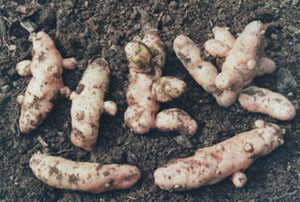
September 1st and a definite autumn feel in the morning. The geese could be heard but they did not come over the garden today. Beech leaves have been falling from nearby trees when there has been a strong puff of wind and already there is a scattering on the lawns and terrace. With the lower temperatures the garden has been slower to dry and this means that it is more difficult to find a day to mow the lawns, the grass has been growing strongly the last few weeks and it has been difficult to keep up with it! On the vegetable plot the first rows of peas have died back and work on clearing them has begun. If there are any pods with seeds are found these are kept and dried to provide seed for next season. We try to collect as many as we can because they always seem better than those we purchase do. There are still some broad beans to be picked and there are still plenty of runner beans. Both of these we must make sure that there is sufficient seed for next year as they are no longer available in the catalogues. All the French potatoes have been harvested and some have been kept for next year's seed. We have started to lift the later pink fir apple potatoes and the crop seems heavy and good.
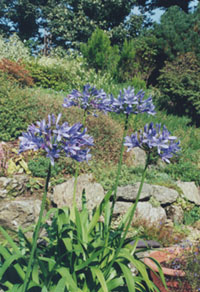
By the 5th the day-lilies, that have given such a good display this summer, had finally stopped flowering. Together with the hydrangeas they were looking rather sad. But our pot grown Agapanthus, the African blue lily, is flowering well on the terrace. This is a challenge to grow here and we have been successful only with pot grown plants. They flower rather late here but seem quite robust with the flowers withstanding any wind and rain. But in the winter, although semi-hardy, it is just too wet for it to survive in the ground. So we keep the plants in pots and when they have finished flowering move them into the shelter of the house. They have survived in this dry northeast-facing corner for several winters. They get covered with dry leaves that we leave around them to give protection from cold weather. In the wood it is still quite dark, as the full canopy of leaves is still largely intact. On the woodland floor the coming autumn has already been signalled by the appearance of a large fungus whose cap measured about 15 cm across the top. It did not last very long as it soon spread its spores, liquefied and had disappeared within 2 or 3 days. Early morning on the 9th was quiet and still, there had been mist lying low across the fields. At 7.15 am I heard geese approaching and was just in time to open the kitchen door and see at least 50 pass overhead in 2 V formations. They had taken off from nearby fields and were heading in a northwesterly direction.
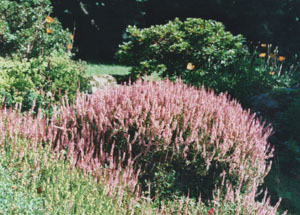
The 11th started off warm and sunny and it was going to be a good day for the butterflies. There were lots about including peacocks, red admirals, speckled woods and best of all two painted ladies. We were very pleased to see these again, as they are rare visitors here. This is an African species that is common in southern Europe and can, in some years, reach Britain in large numbers. They will not survive the winter in northern Europe but it is thought some do manage to return to frost-free regions by southerly migration. They, and the other butterflies, were feeding on Polygonium vaccinifolium of the knotweed family. A native of the Himalayas it was introduced into this country in 1845. This is very hardy and has woody trailing stems, with dark green leathery leaves, and masses of rose-pink flowers. It is a must for a wildlife garden; it flowers from midsummer till autumn filling a period that can be poor for flowers. It is easy to grow and is excellent for attracting butterflies, bees and other insects. Other plants attracting butterflies at the moment include buddleia and marjoram, but these are just finishing, and the French lavenders. Also proving an attraction are the late raspberries. These have been attacked by wasps that have considerably reduced the crop usable for the table. It has been a 'good' year for wasps but they have been a nuisance at times. The wasps seem to concentrate on certain berries and 'soften them up' it is on these that the butterflies feed. At Llandegfan, on several occasions I have seen a dozen, or more, red admirals feeding on rotting plums that had fallen to the ground. The plums had again been first attacked by wasps, softened up and then were attracting the butterflies. When disturbed the butterflies flew up from the ground in a cloud, quite a sight.
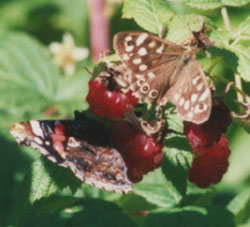
We have a lot of robins about the garden. Many must be this years' brood and all anxious to establish winter territories. They have been singing strongly, at times it has been a chorus of robins. Today, the 24th I counted at least 5 singing in different parts of the garden. We have 'kitchen' robin; he has set up near the bird table that he thinks he owns. Then there is 'greenhouse' robin, he is often to be found in the greenhouse, and 'side garden' robin near the natural thicket we have on the north side of the house. There is of course 'wood' robin No. 1 that is in the entrance to the wood near another feeding table, and 'wood' robin No. 2 that lives at the top end of the wood near the church. I think there are many more judging by the disputes that take place round and about from time to time. They always appear when we are in the garden and if soil is being worked to snap up any grubs turned over. Leave a fork in the ground and walk away and a robin perches on it. The raingauges are prime perching positions and causes a problem particularly with the recording gauge. Droppings can clog up the siphon mechanism! I solved the problem by placing a garden fork close to the gauge. What robin could resist perching on a fork instead? Wrens are also much in evidence at the moment. Their distribution is similar to the robins' with a kitchen, house, greenhouse and wood wren, we think they individual birds. Different species do not matter in the territory stakes; they usually get on all right together. The female pheasant has been visiting the garden but there has been no sight or sound of the male for some weeks. The owls are frequent visitors, we see them sometimes at dusk, or dawn, and hear them hooting at night. There have been a few house martins about the garden, but I was surprised to see as many as 18 flying around high over the trees in the evening. They often assemble to make their long journey south on electricity cables crossing the field to our house in large numbers. Some may have already left and these may be youngsters, from later broods, yet to set off. There was no further work done on the new nest beneath the gable of our house.
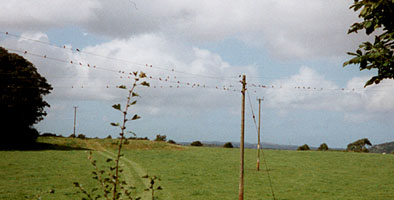
After a gale on the 28th there were more beech leaves on the ground and these had been joined by some sycamore. Many beechnuts also litter the ground and have split open revealing the seed. Under the trees the ground is quite crunchy to walk on. This has been a good year for beech seed and already the wood pigeons are feeding on them. Squirrels have yet to take an interest but I expect it will not take long for them to find them. There are several brown dragonflies flying about, these settle in the sunshine in a warm spot with their wings open. A bright spot on the vegetable plot at the moment are some sunflowers. We feed the birds in the winter with black sunflower seeds that are very popular and attract many birds. Some birds, especially the greenfinches, perch on the feeder, roll the seed in their beaks and consume the kernel on the spot. Others will carry them off and these include nuthatches and coal tits. Nuthatches will take the seed to a favourite tree and break it open, but they will wedge some into crevices to act as a personal store. 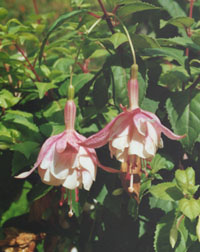 We now think that the coal tits have been taking the seed away and planting them. In the spring a large number of seedlings that looked like sunflowers sprung up all over the place. Pots were a favourite place as well as the vegetable plot. Well, several survived the cultivation and have grown into quite large plants! This month they have bloomed and have provided a bit of colour on the now rather drab looking plot. On a sunny day the flowers have been attracting bees and the odd butterfly as well. Also in bloom along side the vegetable plot are the hop plants. I will gather some and dry them off to add to my beer barrel when next I brew! Some other plants are in flower that should not be at this time of year; we are having a second mini-spring. The Clematis montana on the hedge at the front of the garden, that did so well in the spring, has several blooms and two or three blue Azalea have had some flower for a week or two. Also a large red-flowered Rhododendron is unusually covered with flower. A newly planted C. Ville de Lyon on trellis has several carmine edged crimson flowers, but this is expected as it is a late flowering variety. The potted fuchsias around the terrace, including Annabel, are continuing to produce an abundance of flowers as is our 'all the year round' Pelargonium. Some large fuchsias in the hedge, and elsewhere, have been flowering all summer. These are F. magellanica and have bright red and purple flowers. They seem impervious to rain and wind and are hardy but can be cut down in very cold years; they invariably regrow from the base! They are, importantly, also resistant to salt spay and can be found in hedges near the seashore in many places in the west. Similar forms are also found extensively in southern Ireland and the Azores. We also have a pale-pink variety that is doing very well. An addition to the garden this year is F. magellanica var. Gracilis variegata, which is moderately hardy with creamy-edged variegated leaves with flushed pink flowers. These plants were grown from cuttings from our friend Mari's garden. And, the Welsh poppies continue to bloom...
We now think that the coal tits have been taking the seed away and planting them. In the spring a large number of seedlings that looked like sunflowers sprung up all over the place. Pots were a favourite place as well as the vegetable plot. Well, several survived the cultivation and have grown into quite large plants! This month they have bloomed and have provided a bit of colour on the now rather drab looking plot. On a sunny day the flowers have been attracting bees and the odd butterfly as well. Also in bloom along side the vegetable plot are the hop plants. I will gather some and dry them off to add to my beer barrel when next I brew! Some other plants are in flower that should not be at this time of year; we are having a second mini-spring. The Clematis montana on the hedge at the front of the garden, that did so well in the spring, has several blooms and two or three blue Azalea have had some flower for a week or two. Also a large red-flowered Rhododendron is unusually covered with flower. A newly planted C. Ville de Lyon on trellis has several carmine edged crimson flowers, but this is expected as it is a late flowering variety. The potted fuchsias around the terrace, including Annabel, are continuing to produce an abundance of flowers as is our 'all the year round' Pelargonium. Some large fuchsias in the hedge, and elsewhere, have been flowering all summer. These are F. magellanica and have bright red and purple flowers. They seem impervious to rain and wind and are hardy but can be cut down in very cold years; they invariably regrow from the base! They are, importantly, also resistant to salt spay and can be found in hedges near the seashore in many places in the west. Similar forms are also found extensively in southern Ireland and the Azores. We also have a pale-pink variety that is doing very well. An addition to the garden this year is F. magellanica var. Gracilis variegata, which is moderately hardy with creamy-edged variegated leaves with flushed pink flowers. These plants were grown from cuttings from our friend Mari's garden. And, the Welsh poppies continue to bloom...
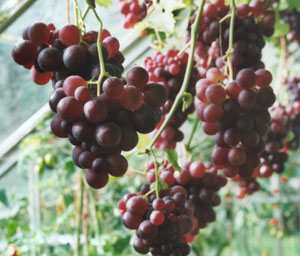
The 29th was quite a pleasant day, in the morning there was a lot of noise as the rooks were paying a flying-visit to the rookery. For several minutes the air was full of rooks, they made their inspection and flew off again. It was quite warm for a while and several large moths were feeding on the long-flowering French lavenders and the 'Brittany' sage. Several butterflies were also still around. Along the greenhouse the chrysanthemums are now quite tall and soon will be transferred to the greenhouse, once it is felt that the tomatoes can be cleared. The chrysanthemums have already survived one gale, on the 27th. I frequently inspect their supports and re-tie any that have become slack. At the same time I go along the row and do any dis-budding that is required. This is a job that Patricia and I do, when we are passing, as it needs to be done frequently. When the terminal flower bud is formed this signals other buds to form, in the axils of the leaves, down the stem. As we like to have individual large flower heads it is necessary to remove the lower buds leaving the terminal bud to develop. It is a pleasant job to do on a sunny day! In the greenhouse the propagating frame is full of various cuttings taken from plants in the garden. The cucumbers have finished but the tomatoes are still ripening well. The first bunches of the Black Hamburg grape are ripe and ready for eating. I have been testing the odd grape for a week or two; it is a question of allowing the whole bunch to ripen evenly. To assist ripening I have been removing leaves to make sure that direct sunlight reaches the grapes. Sadly the outdoor vines, although flowering well, produced no grapes this year.
Document dated: 2 October 2000. This page is part of the site maintained at http://www.llansadwrn-wx.co.uk
Copyright ©: 2000 Donald and Patricia Perkins